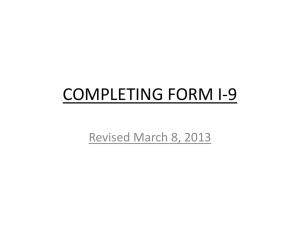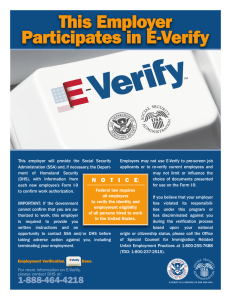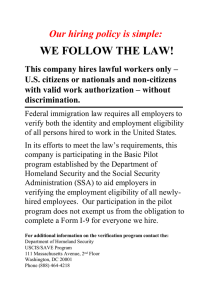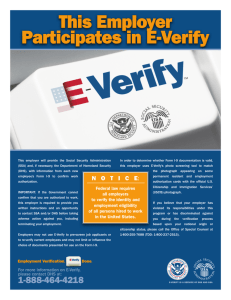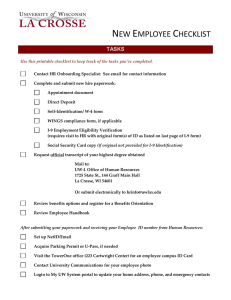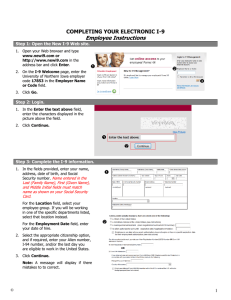Immigration Law Update
advertisement
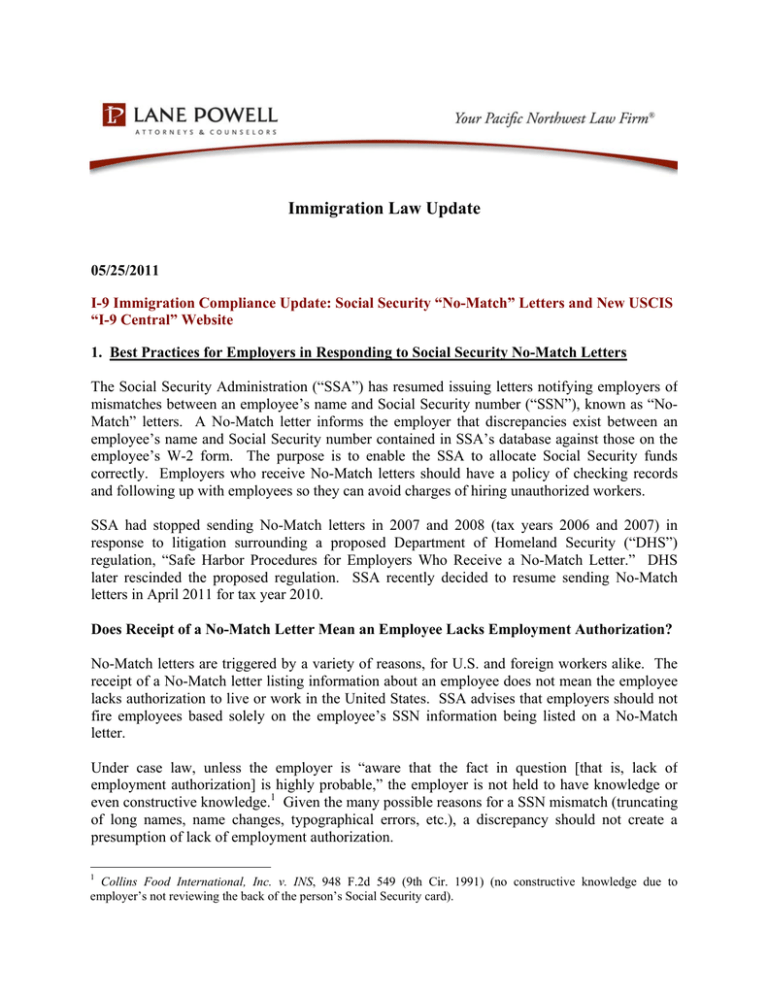
Immigration Law Update 05/25/2011 I-9 Immigration Compliance Update: Social Security “No-Match” Letters and New USCIS “I-9 Central” Website 1. Best Practices for Employers in Responding to Social Security No-Match Letters The Social Security Administration (“SSA”) has resumed issuing letters notifying employers of mismatches between an employee’s name and Social Security number (“SSN”), known as “NoMatch” letters. A No-Match letter informs the employer that discrepancies exist between an employee’s name and Social Security number contained in SSA’s database against those on the employee’s W-2 form. The purpose is to enable the SSA to allocate Social Security funds correctly. Employers who receive No-Match letters should have a policy of checking records and following up with employees so they can avoid charges of hiring unauthorized workers. SSA had stopped sending No-Match letters in 2007 and 2008 (tax years 2006 and 2007) in response to litigation surrounding a proposed Department of Homeland Security (“DHS”) regulation, “Safe Harbor Procedures for Employers Who Receive a No-Match Letter.” DHS later rescinded the proposed regulation. SSA recently decided to resume sending No-Match letters in April 2011 for tax year 2010. Does Receipt of a No-Match Letter Mean an Employee Lacks Employment Authorization? No-Match letters are triggered by a variety of reasons, for U.S. and foreign workers alike. The receipt of a No-Match letter listing information about an employee does not mean the employee lacks authorization to live or work in the United States. SSA advises that employers should not fire employees based solely on the employee’s SSN information being listed on a No-Match letter. Under case law, unless the employer is “aware that the fact in question [that is, lack of employment authorization] is highly probable,” the employer is not held to have knowledge or even constructive knowledge.1 Given the many possible reasons for a SSN mismatch (truncating of long names, name changes, typographical errors, etc.), a discrepancy should not create a presumption of lack of employment authorization. 1 Collins Food International, Inc. v. INS, 948 F.2d 549 (9th Cir. 1991) (no constructive knowledge due to employer’s not reviewing the back of the person’s Social Security card). What are the Best Practices for Responding to a No-Match Letter? Employers can implement the following procedures to clear up discrepancies: As soon as possible after receiving a No-Match letter, the employer should begin reviewing the records of each person whose SSN is listed to determine the following: • Does the person whose name or SSN is listed currently work for the company? • Is there an easily identifiable discrepancy? Examples include a typographical, transcribing, misspelling, name change, truncation or similar clerical error in the employer’s records, such as the following: o o o o Employment Eligibility Verification Form (I-9); Employee’s Withholding Allowance Certificate (W-4); Records on file that list the SSN; and Human Resources department records. If there is an identifiable error, the employer should do the following: • • • • • Correct internal records; Inform the SSA or relevant agency; Verify that the name and number, as corrected, match the agency records; Record the correction; and Update the I-9 to reflect corrections. If the issue is unresolved, notify the employee in writing of the discrepancy. Advise the employee to go to the Social Security office to attempt to resolve it and to report back about actions needed to resolve the discrepancy. Record the status of the efforts to resolve the discrepancy. Under What Circumstances Should an Employer Terminate an Employee After Receipt of a No-Match Letter? If an employer knows an employee lacks work authorization, the employer must terminate the employee or face the risk of subsequent DHS enforcement action. An employer can be found to have constructive knowledge based on the totality of relevant circumstances, which may include receipt of a No-Match letter. Good faith, but ultimately unsuccessful attempts to comply with the law, should be taken into consideration where the employer is subsequently charged with constructive knowledge of hiring unauthorized workers. In any event, an employer should not terminate an employee until the process is completed, unless the employer obtains actual knowledge, such as through an admission by the employee, or the employer believes it is highly probable that the employee is not eligible for employment in the United States. Employers should contact qualified counsel with any immigration-related questions that arise. 2 2. New USCIS I-9 Compliance Web Resource: “I-9 Central” Receipt of a No-Match letter may prompt an employer to reverify employee documents that establish identity and work authorization on the Form I-9 for Employment Eligibility Verification. Reverification is not required solely because an employer has received a No-Match letter. Although an immigration Web-based resource is available for document verification, this resource should be used with caution due to lack of completeness of the information it contains. On May 13, U.S. Citizenship and Immigration Services (“USCIS”) launched a new website called “I-9 Central,” an online resource for employers to access information regarding I-9 compliance. The website includes sections covering employer and employee rights and responsibilities, step-by-step instructions for completing Form I-9, and information on acceptable documents for establishing identity and employment authorization. USCIS has also posted guidance on common mistakes in completing Form I-9, how to correct errors, and how to answer employees’ questions about the I-9 process. While the I-9 Central website is a more user-friendly interface to obtain information than other USCIS publications, such as the Form I-9 itself, it is not a comprehensive resource regarding I-9 issues. For example, the website’s section on “Acceptable Documents” contains images of only the most recent versions of legitimate, U.S. government-issued documents, while employers must be careful to accept any versions of valid, unexpired documents. For complicated issues, employers should continue to seek the advice of counsel or refer to more comprehensive government instructions, such as those in the 2011 version of the M-274, Handbook for Employers: Instructions for Completing Form I-9. The I-9 Central website can be visited at: http://www.uscis.gov/I-9central. The latest version of the M-274 Handbook, updated in January 2011, is also available online at: http://www.uscis.gov/files/form/m-274.pdf. For more information, please contact the Immigration Practice Group at Lane Powell: bus.immigrtn.atty@lanepowell.com This is intended to be a source of general information, not an opinion or legal advice on any specific situation, and does not create an attorney-client relationship with our readers. If you would like more information regarding whether we may assist you in any particular matter, please contact one of our lawyers, using care not to provide us any confidential information until we have notified you in writing that there are no conflicts of interest and that we have agreed to represent you on the specific matter that is the subject of your inquiry. Copyright © 2011 Lane Powell PC Seattle | Portland | Anchorage | Olympia | Tacoma | London 3
